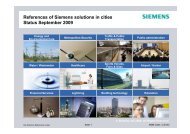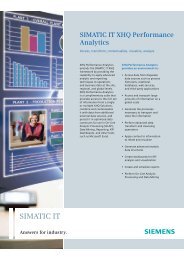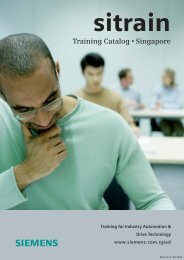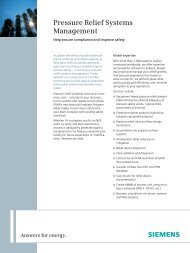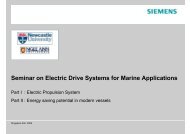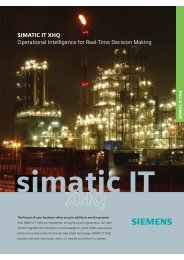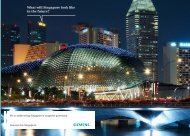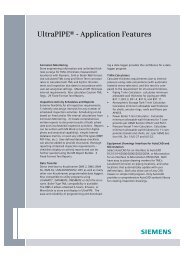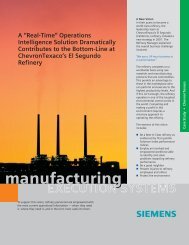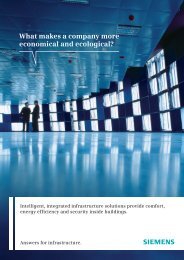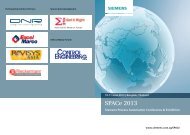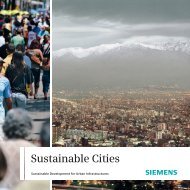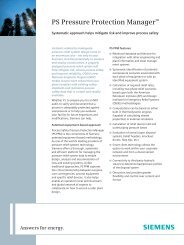Wireless Flexibility - Siemens
Wireless Flexibility - Siemens
Wireless Flexibility - Siemens
Create successful ePaper yourself
Turn your PDF publications into a flip-book with our unique Google optimized e-Paper software.
Strengthened by the high quality and reliability<br />
of its products, <strong>Siemens</strong> has chosen to<br />
propose the best and most suitable technology<br />
for each application instead of having a multicomponents<br />
system with a global average result.<br />
All <strong>Siemens</strong> analyzers are compliant with the latest<br />
regulations in Europe, Asia and US (TUV, QAL1...etc).<br />
Furthermore, in order to bring a complete solution<br />
to its customer, <strong>Siemens</strong> is able to propose the<br />
system integration (sampling and conditioning system,<br />
shelter), maintenance and service contract<br />
through its own local or regional office and partners<br />
network.<br />
Non Dispersive Infra-Red (NDIR) Analyzer<br />
Since all gases absorb infrared light energy of various<br />
wavelengths, multiple gas mixtures, even with<br />
very complicated absorption spectra, can be accurately<br />
quantified using this technique. <strong>Siemens</strong> developed<br />
an original and efficient design by using double<br />
or triple layer detectors filled with the measuring<br />
component. One broad bandwidth IR source is used<br />
for all components and the selection is realized inside<br />
the detector with no moving part.<br />
The Ultramat 23, by using this specific technique,<br />
allows to measure up to three IR components simultaneously<br />
with the option of an additional electrochemical<br />
cell for O2 measurement. Measured components<br />
are CO, NO(x), SO2, CO2 and O2.<br />
For emission monitoring in large combustion plant<br />
or incineration plant, the Ultramat 23 is the benchmark<br />
solution.<br />
Its main advantages are the use of cleanable sample<br />
cell, of no moving part and the possibility to perform<br />
a calibration with ambient air by using the so<br />
called “AUTOCAL”. These key factors make the Ultramat<br />
23 to have the lowest cost of ownership on the<br />
market.<br />
In-situ Laser spectroscopy<br />
The basic principle of the diode laser absorption<br />
spectroscopy is the use of a laser beam crossing a<br />
stack. One of the characteristics of the laser is its monochromatic<br />
feature and therefore emits only one<br />
specific wavelength resulting in a low interferences<br />
with other gases.<br />
The laser beam being absorbed by the specific gas<br />
molecules reaches the receiver with a lower intensity.<br />
The Intensity absorbed by the molecule is then directly<br />
proportional to the concentration of this molecule<br />
in the gas volume. The LDS 6 is a single (or dual)<br />
gas analyzer, which can simultaneously measure at 3<br />
locations. From the central unit to the sensors, there<br />
The LDS 6 in-situ laser spectrometer<br />
is a robust optical fiber which can lengthen up to<br />
1000m. An important difference with any other in<br />
situ technology is the use of the second derivative<br />
calculation of the signal which allows to be independent<br />
of the transmission condition as opacity of the<br />
stack, and water droplet.<br />
Due to the very low concentration of HF and HCL to<br />
be measured for the emission monitoring and their<br />
high reactivity with their environment, the in situ Laser<br />
LDS6 is the perfect solution. An extractive system,<br />
because of the sampling line, will cause the loss<br />
of these components. Therefore, the high selectivity<br />
of the laser LDS6 and its high sensitivity allows<br />
measurement of the HF, HCL and H2O.<br />
The last important feature to remember is its quasi<br />
inexistent maintenance due to the absence of consumable,<br />
moving part and the permanent self calibration<br />
by using a build-in reference gas cell.<br />
A new WTE plant in Singapore<br />
The future waste-to-energy plant and Singapore’s<br />
fifth, is expected to be running in operations in early<br />
2009. <strong>Siemens</strong> will provide the equipment - Ultramat<br />
and LDS 6, for the continuous emission monitoring<br />
system. When completed, the plant will be able<br />
to treat 800 tones of solid waste a day to generate<br />
more than 20MW of energy. <br />
p<br />
info<br />
contact<br />
www.siemens.com/processanalytics<br />
frederic.thielland@siemens.com<br />
Pictures: <strong>Siemens</strong> AG<br />
ideas singapore | 2008 21



